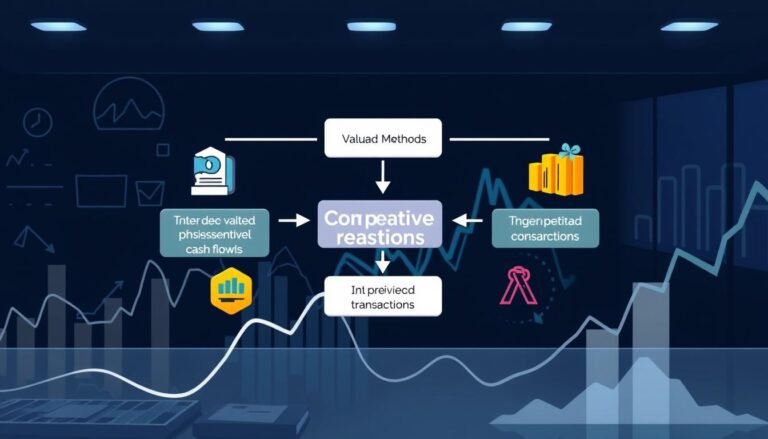How to Develop a Strategic Mindset as a Finance Professional
Are you using your financial skills to their best, or just doing the basics? In today’s fast-changing finance world, having a strategic mindset can make all the difference. It can turn your career around by making your daily work more impactful.
This article will show you how to bring a strategic approach into your finance work. We’ll talk about why it’s key for your career growth. You’ll get tips and ideas to improve your decision-making and aim for lasting success in finance.
Key Takeaways
- Understand the importance of a strategic mindset in the financial industry.
- Learn the components essential for developing a strategic approach in finance.
- Discover steps to begin thinking strategically and enhance decision-making.
- Gain insights into setting long-term financial goals effectively.
- Recognize the role of financial leadership in fostering a strategic culture.
- Explore the significance of leveraging technology and continuous education.
Understanding the Importance of a Strategic Mindset in Finance
In today’s fast-paced financial world, having a strategic mindset is key for finance pros. It’s not just about crunching numbers. It’s about seeing the future and making smart choices that help now and later.
Why Strategic Thinking Matters
Strategic thinking is vital for finance pros. It lets them spot challenges and chances, plan ahead, and match their actions with big goals. This skill makes sure financial plans are strong and can handle different market situations.
Impact on Career Growth
Strategic thinking boosts a finance career. Those who think this way are ready for leadership roles. They can handle tough financial issues and help shape the company’s future. This leads to faster career growth and more job happiness.
Benefits for Financial Organizations
When finance pros think strategically, it helps companies a lot. It gives them a competitive edge, lets them quickly adjust to market shifts, and encourages new ideas. This leads to a strong strategy that matches the company’s goals, driving lasting success and profits.
| Aspect | Benefits |
|---|---|
| Enhanced Forecasting | Accurate long-term financial predictions |
| Proactive Risk Management | Identifying and mitigating potential risks |
| Improved Resource Allocation | Optimal use of financial resources |
Components of a Strategic Mindset for Finance Professionals
To succeed in finance, you need to blend several key elements. Focus on analytical skills in finance, think long-term, and make smart decisions even when things are uncertain. This way, you build a strong strategic plan.
Analytical Thinking
Analytical thinking is vital for finance strategy. It means looking closely at financial data, spotting trends, and finding insights for making decisions. Being able to break down complex info and turn it into useful strategies shows your analytical strength. Finance pros must keep improving their analytical skills to lead.
Long-term Vision
A key part of being a financial leader is seeing how today’s choices will affect tomorrow. Finance strategy is not just about solving today’s problems. It’s also about planning for growth and stability over time. You need to predict future trends, grab new chances, and avoid risks.
Decision Making Under Uncertainty
Making good decisions when you’re not sure is key to finance leadership. With constant changes and surprises, finance pros must learn to balance risks and rewards. Analytical skills help them look at different scenarios and choose wisely, keeping their goals in mind.
Steps to Start Thinking Strategically
For finance pros, having a strategic mindset is key to career success. By taking steps to improve your strategic thinking, you can boost your analytical skills. This makes you more effective in finance.
Developing Analytical Skills
Improving your analytical skills starts with diving into data analysis. You need to understand financial statements and use statistical tools. Keeping up with market trends is also crucial.
Practicing regularly and applying what you learn to real situations helps a lot. This way, you can improve your analytical skills.
Embracing Continuous Learning
Learning never stops for strategic thinking. Getting advanced degrees or certifications can give you new insights. It also boosts your expertise.
Going to industry conferences and workshops keeps you updated. It helps you stay current with the latest trends.
Networking and Seeking Mentorship
Connecting with others in your field is very important. Building a strong network through events and associations can lead to new opportunities. It also gives you different viewpoints.
Getting advice from experienced mentors is also key. They offer guidance, support, and practical tips. This helps you handle complex financial situations better.
By following these steps, finance professionals can develop a strategic mindset. This prepares them for long-term success and adaptability in a changing financial world.
How to Develop a Strategic Mindset as a Finance Professional
For finance pros, having a strategic mindset is key to career success. By cultivating a strategic approach in finance, you boost your decision-making skills. This helps you contribute more to your company’s goals. Here’s how to develop this vital skill:
Start by making strategic thinking a part of your daily work. Look at financial trends and data to spot chances and risks. Create detailed reports and forecasts to prepare for challenges and adjust your plans.
Set short-term goals for immediate needs and a long-term vision for bigger goals. This keeps you focused on both the now and the future.
Next, work on your analytical skills by questioning and checking your assumptions. Keep learning with advanced degrees, certifications, and workshops. Networking and getting mentorship also offer valuable insights and new views on cultivating a strategic approach in finance.
Learning to make decisions when things are uncertain is also key. Use scenario planning and risk analysis to make smart choices. A diverse team and brainstorming can lead to new ideas and strategies for growth.
Lastly, help set long-term financial goals and strategies. Mix short-term targets with long-term visions for lasting success. Keep checking and tweaking your plans based on results and feedback to stay ahead in a changing financial world.
| Tactic | Short-term Benefits | Long-term Benefits |
|---|---|---|
| Daily Financial Analysis | Quick response to market changes | Informed strategic decisions |
| Advanced Education & Networking | Enhanced knowledge & skills | Broader professional network |
| Scenario Planning | Preparedness for uncertainties | Resilience and adaptability |
| Collaborative Decision-making | Diverse perspectives | Innovative solutions |
Setting Long-term Financial Goals
Creating a strong path to financial success starts with setting clear long-term goals. A key part of financial strategy development is making a detailed plan. This plan should match your personal dreams and the wider market trends.
Looking ahead with every financial choice is crucial. It helps in building a solid strategy. With a long-term vision in finance, you can handle surprises and grow your career.
- Set specific, measurable financial targets.
- Study market trends to guess what’s coming next.
- Keep checking and tweaking your plan to stay on track.
A good financial strategy development plan includes these steps for ongoing success. Also, focusing on long-term goals helps finance pros make a big impact. It builds a culture of smart planning in your team.
Role of Financial Leadership in Strategy Development
Financial leadership is key in creating and carrying out strategies in a company. A strong financial leadership mindset means more than just managing money. It’s about leading the way for big plans that help the company grow. Finance leaders are vital in shaping their company’s future through smart financial choices.
Leading by Example
Being a good leader in finance means leading by example. When top finance people show great strategic decision making in finance, it inspires the whole team. Their skill in handling tough financial issues and making smart choices is a lesson for everyone. It builds a culture of high standards and hard work.
Encouraging Innovative Ideas
Innovation is key to growth, and welcoming new ideas is essential for financial leaders. By encouraging team members to think creatively and suggest new solutions, leaders can unlock hidden potential. This approach boosts strategic decision making in finance and keeps the company competitive.
Building a Culture of Strategic Thinking
It’s important to create a culture that values strategic thinking at every level. Financial leaders need to make sure everyone sees how their role fits into the big picture. This way, employees can make choices that support the company’s goals. It builds a united and forward-looking team.
Financial Analysis and Strategic Planning
It’s key to understand how finance analysis for strategy and strategic planning in finance work together. This is especially true for businesses looking to succeed in tough markets. By analyzing finances deeply, companies can find important insights. These insights help shape their strategies, use resources wisely, and predict future growth.
At the heart of strategic planning in finance is a detailed look at important financial numbers. This means checking past data, spotting trends, and guessing future results. This way, finance experts can make a solid plan that looks at different financial possibilities and outcomes.
A full finance analysis for strategy includes several key areas:
- Revenue Analysis
- Cost Analysis
- Profit Margins
- Operational Efficiency
- Risk Assessment
But financial data in planning is more than just numbers. It also needs critical thinking to understand and use the findings. For example, looking at profit trends helps companies decide on products or expanding into new markets.
The table below shows some top ways to mix finance analysis with planning:
| Best Practice | Description | Impact |
|---|---|---|
| SWOT Analysis | Identifying strengths, weaknesses, opportunities, and threats based on financial data. | Provides a comprehensive view of internal and external factors affecting the business. |
| Balanced Scorecard | Utilizing performance metrics to align business activities with strategic goals. | Ensures that all organizational efforts contribute to long-term objectives. |
| Zero-based Budgeting | Building budgets from scratch each period based on actual needs and costs. | Improves allocation of resources and reduces unnecessary expenditures. |
Mixing finance analysis for strategy makes sure plans are based on real data. This mix is ongoing and helps make better decisions. It also gets companies ready to face challenges and grab new chances for growth.
Importance of Scenario Planning in Finance
Scenario planning in finance is key for finance pros to get ready for many possible futures. They look at different scenarios to make plans that handle risks well.
Looking at many scenarios helps financial analysts spot chances and see problems before they happen. This way, they stay ready for sudden market changes, keeping finances stable.
Scenario planning in finance has many benefits:
- Enhanced Decision Making: A good plan for different scenarios helps finance pros make smart choices fast.
- Risk Mitigation: Knowing risks ahead lets them plan ways to lessen those risks.
- Improved Flexibility: Companies can change quickly to market shifts.
Now, let’s look at how scenario planning in finance compares to managing financial risks:
| Aspect | Scenario Planning in Finance | Financial Risk Management |
|---|---|---|
| Objective | To predict and prepare for multiple future outcomes. | To identify, analyze, and mitigate financial risks. |
| Approach | Developing various hypothetical situations. | Analyzing potential risks through qualitative and quantitative methods. |
| Outcome | Creation of adaptable strategies for different scenarios. | Minimization of the impact of financial risks on the organization. |
In summary, scenario planning in finance is vital for managing financial risks. By looking at different futures, finance pros get the tools to face unknowns with more confidence.
Leveraging Technology for Strategic Financial Decisions
Advanced technology is changing how finance experts make big decisions. With new tools, complex financial tasks are easier and more efficient. This section looks at the main technologies helping make strategic financial choices today.
Adopting Financial Software
Using financial software is key in today’s finance world. These tools help manage data, make workflows smoother, and aid in making smart choices. Thanks to tech progress, these software systems are easy to use and powerful, giving instant insights and handling routine tasks.
Utilizing Big Data
Big data is changing finance, giving deeper insights and better predictions. By looking at lots of data, experts can spot trends, predict market shifts, and make informed decisions. This helps improve financial planning and lets for early strategy planning.
Artificial Intelligence in Financial Planning
The use of AI in finance is growing, offering unmatched analytical power. AI systems can handle complex data, find patterns, and give insights that were hard to get before. By using AI in planning, experts can better manage investments, risks, and strategies.
By using these technologies, finance pros are leading the way in innovation. They can confidently and strategically move through the financial world.
Cultivating a Strategic Approach Through Continuous Education
For finance pros, keeping up with the latest in finance is key. By always learning, getting certified, and using other development tools, you can think strategically. This keeps you current in the field.
Advanced Degrees and Certifications
Getting an MBA or a financial certification like the CFA boosts your strategic skills. These programs give deep knowledge and a wide view of finance. They’re crucial for thinking strategically.
Workshops and Seminars
Workshops and seminars offer hands-on learning and networking chances. They feature top industry leaders and experts. They share new trends and insights, helping you stay updated in finance.
Online Courses and Webinars
Online courses and webinars are easy to use and flexible. Sites like Coursera, LinkedIn Learning, and Khan Academy have many finance topics. They’re great for improving your skills without a full degree.
Building a Strong Financial Network
In the fast-paced world of finance, having a strong professional network is key. A good network in finance can lead to partnerships, projects, and understanding market trends. It’s not just about swapping business cards; it’s about building relationships that help you grow and find new opportunities.
The Role of Professional Associations
Joining professional finance associations is a great way to connect. These groups offer a chance to meet others, share knowledge, and keep up with industry news. Being part of these associations can help your career by giving you a sense of community and belonging.
Networking Events and Conferences
Going to networking events and conferences is also crucial. These events are perfect for meeting experts, learning about new trends, and making contacts. By being active at these events, you can show your skills, learn from others, and find partnerships that can boost your career.
Building Relationships with Peers
It’s also important to connect with peers in everyday life. Use social media like LinkedIn or meet up with colleagues to stay in touch. A strong network of peers can offer mentorship, collaboration, and a place to share ideas. This helps you stay updated and grow strategically.
| Benefits of Networking | Examples |
|---|---|
| Strategic Partnerships | Collaborating on joint ventures |
| Industry Insights | Learning about market trends |
| Career Advancement | Mentorship and job referrals |
Case Studies of Successful Financial Strategies
Looking at finance strategy success stories helps finance pros learn from others. Seeing how people turn vision into success is truly inspiring. It shows the power of strategic planning in finance.
Companies like Apple and Amazon are great examples. Apple focuses on innovation and long-term goals, leading to big profits. They invest in R&D and make products that stand out, keeping ahead of rivals.
Amazon puts customers first and diversifies, growing financially and expanding in the market. Their approach to strategic decision-making is key to their success.
Now, let’s dive into a retail example:
| Company | Strategy | Outcome |
|---|---|---|
| Walmart | Investment in E-commerce | Significant growth in online sales, enhanced market share |
| Target | Omni-channel Retailing | Increased customer engagement, higher revenue per customer |
By studying case studies in finance, finance experts can spot strategies that work for them. Learning from others’ wins motivates and guides them to avoid mistakes. It helps them craft their own winning finance strategy.
Challenges in Developing a Strategic Mindset
Getting a strategic mindset in finance is tough. Finance pros face many obstacles to strategic thinking in finance. These include not wanting to change, too much information, and biases.
Resistance to Change: One big obstacle to strategic thinking in finance is not wanting to change. Finance pros often stick to what they know, even if it’s not the best way.
Information Overload: Too much data is another big challenge. With so much financial info, it’s hard to know what’s really important.
Cognitive Biases: Biases like being too sure of oneself or only seeing what confirms what you think can mess up strategic thinking.
To beat these obstacles to strategic thinking in finance, try these tips:
- Encourage Collaborative Environments: Create a team culture that values everyone’s ideas. This can help overcome the fear of change.
- Implement Data Management Tools: Use tools that make data easier to handle and find the most important info.
- Promote Awareness of Cognitive Biases: Training can help finance pros see and avoid biases. This leads to better, more strategic choices.
By tackling these common obstacles to strategic thinking in finance, finance pros can get better at making strategic decisions. This leads to success in the long run.
Measuring the Success of Your Strategic Approach
In today’s fast-changing finance world, it’s vital to measure your strategy’s success. A solid strategy and good performance tracking are crucial for lasting success.
Key Performance Indicators (KPIs)
Key Performance Indicators (KPIs) are great for checking if your financial plans work. By tracking KPIs like ROI, net profit margin, or liquidity ratios, you can see how well you’re doing. This helps you make smart choices based on facts.
Keeping an eye on these numbers helps your team focus on what’s working and what needs work. This way, you can act before problems arise.
Review and Adjustment Processes
It’s important to regularly check your KPIs to keep them accurate and up-to-date. Set up regular review times, like monthly or quarterly, to check if your plans are working. This helps you make quick changes when needed.
This method keeps your organization flexible and competitive in the market.
Feedback and Improvement
Getting feedback is key in finance performance tracking. Encourage a culture of ongoing improvement to boost your strategy’s success. Listen to your team, stakeholders, and financial data to find ways to get better.
Regular feedback helps keep your strategy fresh and ready for new challenges and chances.
Conclusion
In today’s world, having a strategic mindset is key for finance pros aiming for long-term success. A strategic approach boosts both personal growth and the success of financial teams. It involves analytical thinking, using technology, and planning for different scenarios.
Setting long-term goals and leading with financial wisdom are crucial. They help finance pros face uncertainty with confidence. By developing analytical skills and building a strong network, they can make smart financial decisions.
Case studies show the deep benefits of a strategic mindset. By using key performance indicators and staying adaptable, strategies stay effective. A good financial strategy looks to the future, not just for quick wins.
Now is the time to put these ideas into action. By doing so, you can grow your career and help your organization thrive. Start strategizing for finance success today and see the positive changes it brings.








